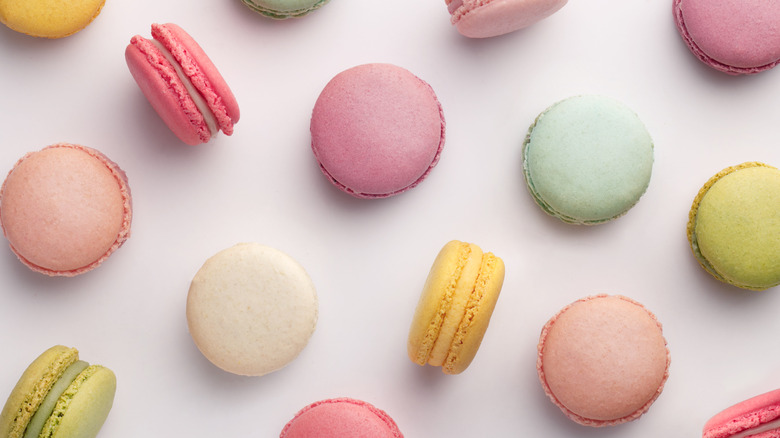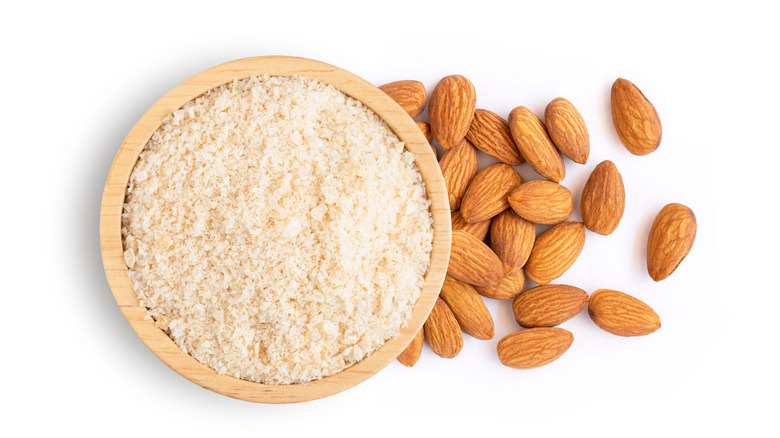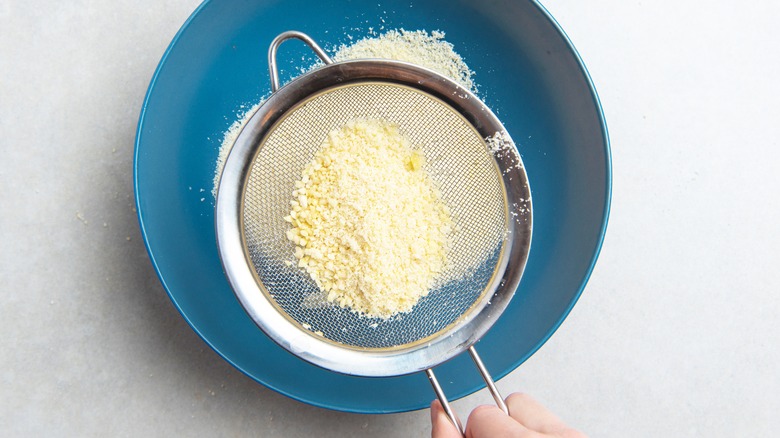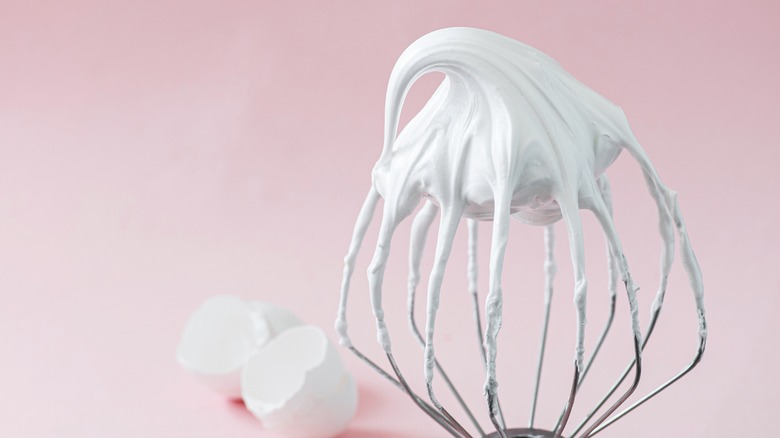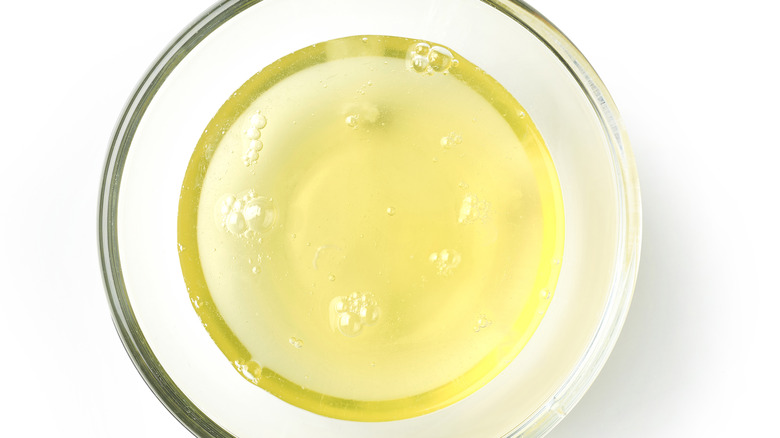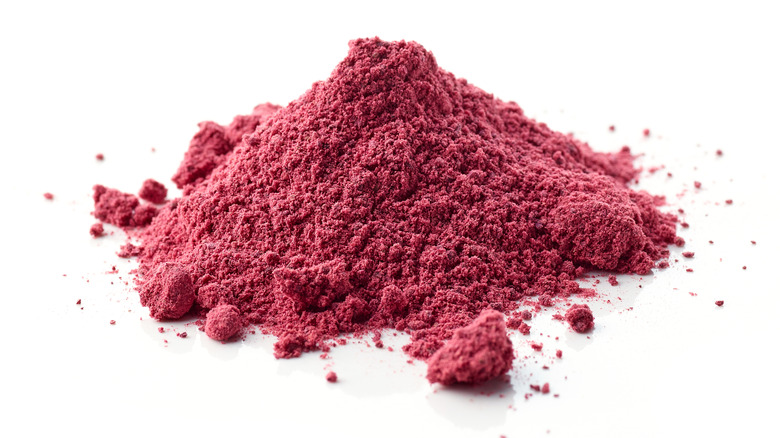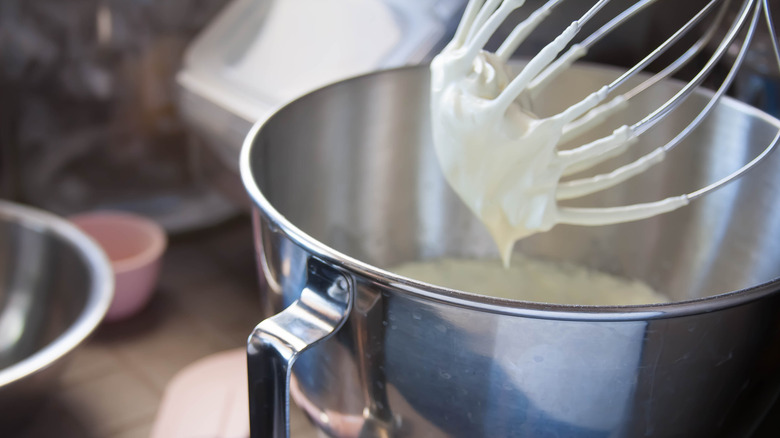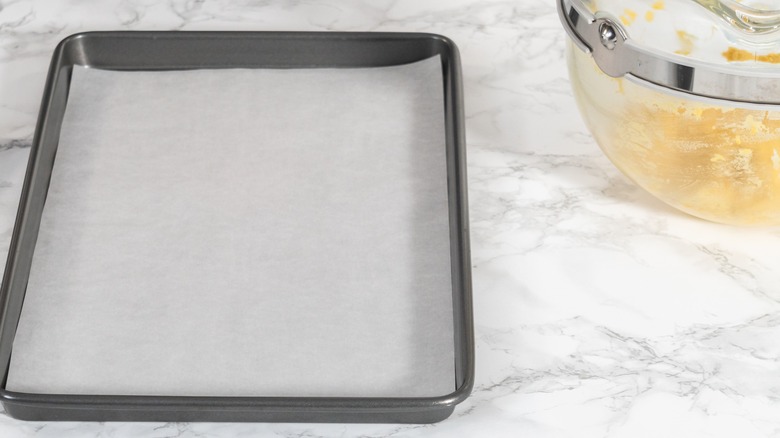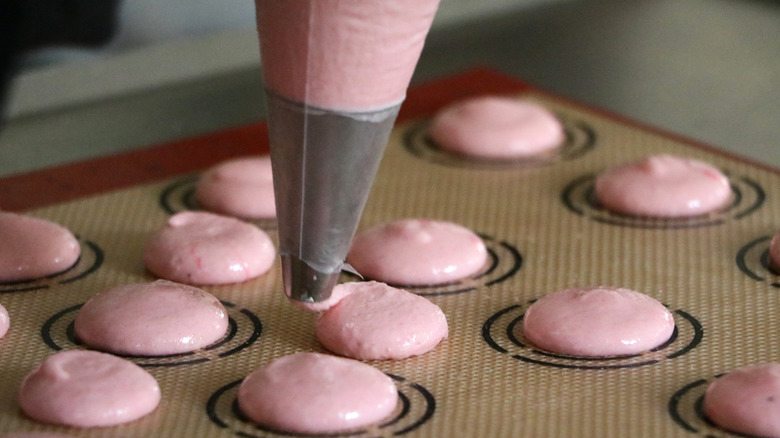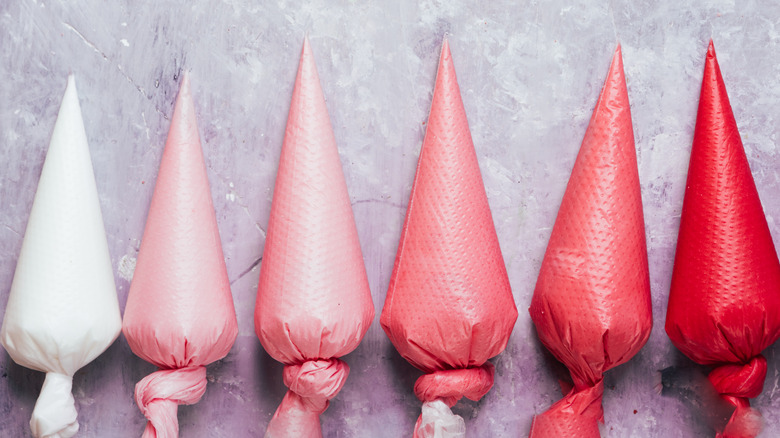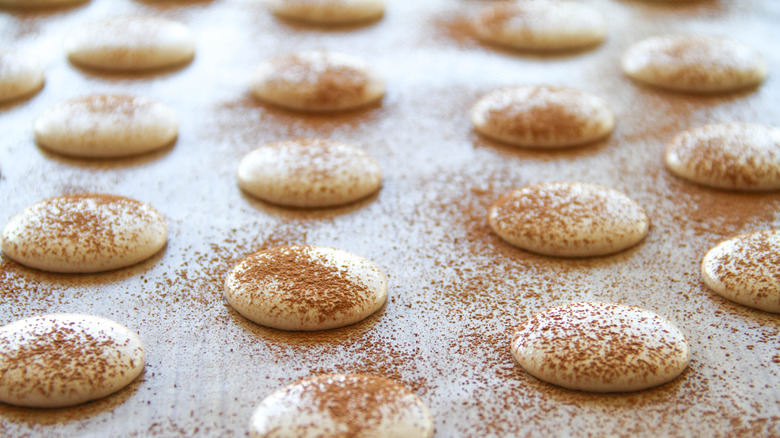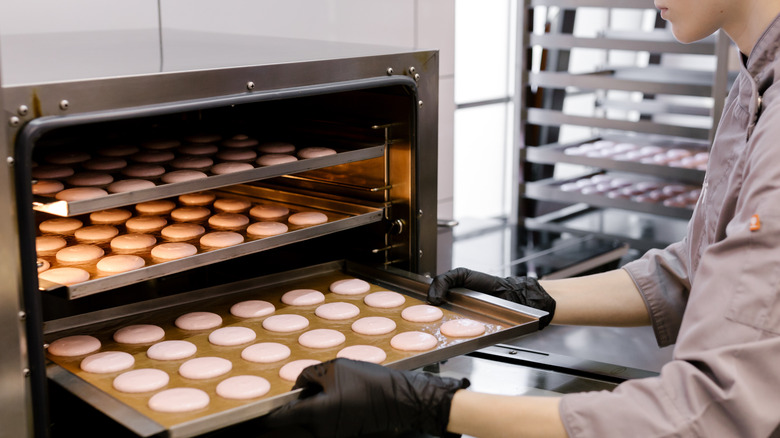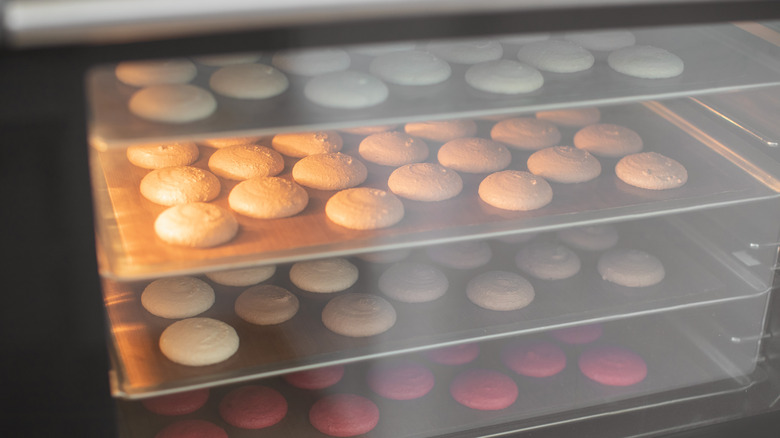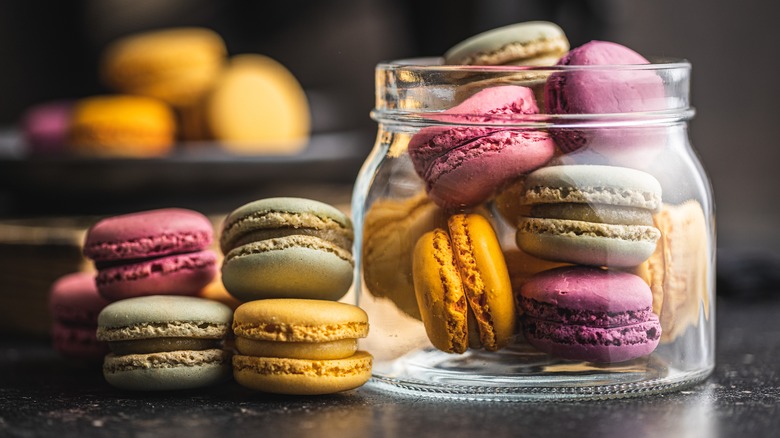The 13 Biggest Mistakes To Avoid When Baking Macarons
We may receive a commission on purchases made from links.
Macarons are a delicious treat in bakeries across France and around the world. These colorful sandwich cookies usually encapsulate a jam or a ganache with delicate, almond-based cookies. While these treats look almost too dainty for a home cook to craft at home, with a little practice and a few tips, you can make your own macarons from the comfort of your home kitchen.
We consulted with pastry expert Amanda Schlarbaum from the King Arthur Baking Company (KABC) Baking Hotline to help us set you up for success when you bake your next batch of macarons. Schlarbaum and the team at the KABC Baking Hotline help bakers work through troublesome batches of bread dough, sticky choux, and worrisome pastries. If you get stuck in your holiday season baking or any other time throughout the year, you can contact the hotline by phone or email to get all of your questions answered.
Substituting almond flour with another flour
The recipe for French macarons shells is pretty standard: confectioner's sugar, egg whites, and almond flour, which is much finer than almond meal because of the grinding. If you have a tree-nut allergy, or just want to experiment with other types of flour, you might be inclined to just substitute another kind of flour for almond flour. But this simple swap will inevitably result in disaster. Macarons are supposed to be made with almond flour for several reasons. The combination of almond flour with a stiff meringue is ideal for piping. The resulting texture when you bite into these cookies is soft, plush, and melt-in-your-mouth. All-purpose flour just wouldn't produce the same result.
Amanda Schlarbaum notes that although some folks have tried to make macarons out of other nut flours, the result isn't the same either. "You can try another nut or experiment with seeds, like pumpkin or sunflower, but it won't produce the traditional macaron in color nor flavor."
Be sure to opt for blanched almond flour, which does not contain the peels of the nuts. (The peels are full of oil, which may further disrupt your recipe.) Using blanched almond flour will help to ensure a smooth texture for your macarons.
Forgetting to sift the ingredients together
Sifting is important to ensure the ingredients are evenly dispersed rather than lumpy. Sifting the almond flour before adding other ingredients adds air. The resulting texture in the macaron is smooth, velvety, and of course — airy. Amanda Schlarbaum notes that sifting the sugar and the almond flour is important to remove coarse pieces that would otherwise weigh down the batter or clog your piping tip. This in turn will keep the batter both lighter and easier to blend when you incorporate the meringue.
You should use a medium-mesh rather than a fine mesh sieve to sift your almond flour — a fine mesh sieve is just too small for the particle size of the almond flour. If you do not have access to a sieve, you can use a standard-sized colander or handheld sieve to sift your almond flour and sugar before mixing the two together.
Picking the wrong meringue to add to your batter
There are many types of meringue to choose from when you're making macarons. French meringue involves beating egg whites and granulated sugar. A Swiss meringue involves beating sugar and egg whites over a double boiler. And then there is Italian meringue, which uses a cooked sugar syrup instead of granulated sugar.
To make the perfect French macarons, you need to use Italian meringue which is more sturdy than its two distant meringue cousins. The hot sugar syrup is made with a 2-to-1 ratio of sugar to water. When the eggs are rapidly whipped with the syrup, the egg whites cook ever so slightly and result in a glossy finish. The trick to making the perfect meringue is to ensure the temperature of the hot sugar syrup is close to 240 F and then slowly pour the syrup into the beaten egg whites until stiff peaks form.
Using egg whites from a carton
If you want to avoid wasting food in your kitchen, you might opt to purchase egg whites in the carton rather than bring home a dozen eggs. But Amanda Schlarbaum recommends sticking with fresh eggs. According to a study in Poultry Science (via Science Direct), carton egg whites may contain emulsifiers, stabilizers, and other ingredients that alter the quality of the meringue. You should also make sure your eggs are at room temperature for maximum stability in the meringue.
Another big mistake people make when making meringue is accidentally getting egg yolk caught in the egg whites. According to Science Sparks, the fat in the yolk interferes with the protein in the whites. You can omit the egg yolk by breaking the egg in a separate bow or by using an egg separator tool. And if you're looking for a way to use up those leftover egg yolks, you should undoubtedly make crème brûlée next.
Using liquid food coloring
Macarons often come in pretty pastel shades of pink, blue, and yellow. To get that pop of color in your macarons, you'll have to use food coloring. But before you reach for the multi-pack of liquid food dye in your cabinet, think again.
Moisture is the enemy of the perfect macaron. Instead of using liquid food coloring, stick to a powdered or gel coloring. Since gel food coloring is made from a base of glycerin or corn syrup, it won't alter the ratio of liquid in the batter. Most powdered dyes are made from synthetic colorings which won't change the consistency of the macaron. Since the powdered color is so concentrated, you'll only need to use about ¼ teaspoon of powder for a whole batch.
If you want to avoid using a synthetic coloring, consider other "natural" food dyes like beetroot powder, turmeric, freeze-dried raspberries, or hibiscus flower.
Over-mixing the macaron batter
The concept behind adding meringue to the almond flour for macarons is called "macaronage." Pastreez notes the first step in crafting the best possible macronage is to start with half of the almond and meringue mix. Smoothly bring the bottom of the bowl up to the top. You'll know your batter is finished and ready-to-go when you can form a figure-8 with the spatula and the texture is glossy. Another thing to note is that humidity is not kind to macarons, so be aware of your environment.
Amanda Schlarbaum recommends sacrificing a single macaron to see if it can hold its shape on the parchment to tell if your batter is ready to bake. The macaron should not be so weepy that it flattens like a pancake when it hits the pan, but it should wiggle enough that when you smack the pan against the counter, the macaron relaxes.
Not lining the pan before you pipe your macarons
Lining your pan is important to make sure your macarons don't stick during baking. Amanda Schlarbaum's go-to liner is good-old parchment paper. If you use parchment, you can draw rings with the rim of a glass to ensure all of your macarons are the same shape. For easy parchment paper use (for more than just macarons), consider purchasing pre-cut parchment paper sheets.
Silicon baking pans are another option, but there are some caveats. Silicon tends to harbor oils more easily than parchment paper. Since oil is the death of macarons, leaving traces of it on the silicon mat may destroy your macarons. Silicon mats also hold heat differently than parchment because of their thickness. You can also cut the parchment paper to size while silicon mats need to be bought based on the size of your pan, so you have slightly less flexibility when working with the material.
Not doing a practice piping
You can't expect to pipe perfectly-sized macarons on the first try, especially if you're a novice. Amanda Schlarbaum recommends putting aside a couple of macarons to learn how to pipe, orient yourself, and ensure you're getting the perfect angle on your bag. This will also give you an opportunity to test your batter's macronage and moisture content. It's totally fine if these first couple of macarons go into the garbage rather than your pastry tray.
"If you've never held a piping bag in your life, it can be hard to figure out how to do so many things at once and pipe your macarons," Schlarbaum says. "It's gonna be messy." If you don't feel comfortable handling a piping bag, Schlarbaum recommends trying a cookie scoop instead. You'll want to use a teaspoon-sized scoop to plop the perfect amount of batter onto your parchment or silicon baking mat.
Overfilling your piping bag
Regardless of whether you're making macarons or not, all bakers should know the importance of a properly-filled piping bag. Amanda Schlarbaum notes that one of the most common calls the King Arthur Baking Company Baking Hotline receives is regarding overfilling pastry bags. "When you're making macarons, it is easier to maneuver a piping bag that is only ⅓ to ½ of the way filled rather than filled to the brim with macaron batter," Schlarbaum says. "Even though it's a pain to constantly refill your piping bag, you'll have more stability of the bag when you're piping."
If you want to fill your pastry bag with ease, we recommend creating a setup using a wide-mouth jar. You can fold the ends of the bag over the jar for security while spooning in your macaron batter. This method will ensure your hands stay clean while keeping your bag wide open for when you need to add more batter.
Forgetting to rest your macarons after piping
Resting the macarons is otherwise referred to as a drying period, per Amanda Schlarbaum. During this one to two-hour period, the macarons are exposed to air, which allows some of the remaining moisture to evaporate. The exact time will depend on your kitchen environment, so Scharbaum notes the best way to test and see if your macarons are ready for the baking stage is to sacrifice one to the touch test.
When you touch the macaron gently, it should not stick to your fingers but instead hold its shape on the parchment paper, per Schlarbaum. The macaron should also be shiny but not have any residual moisture on the surface. And although this step may take a lot more time than you wish it did, it is important to prevent the bubbling of the macaron feet or opening air pockets in the shells when you are ready to fill them.
Baking in an oven that is too hot
Macarons need to bake low-and-slow in your oven. Schlarbaum notes that most macaron recipes will run in the mid-to-high 200 F to low 300 F range for about 20 to 30 minutes. "This is not a chocolate chip cookie where you can walk away at 350 F," Schlarbaum jokes. The oven just further dries out the shells of the macarons; it is not really meant to cook the macaron.
Overcooked macarons will exhibit several clear signs including dark spots on the feet and cracks in the shells. Not only will overcooking ruin the dainty pastel appearance of your macarons, but it will also cause your cookies to go astray from their signature soft, pillowy goodness. When in doubt, it's always best to read the recipe for the exact temperature and cooking time for your macarons, along with any special instructions (like rotating the pan or cooking on a rack in the middle of the oven) to ensure your bake goes smoothly .
Prematurely removing the macarons from the oven
So if your inclination is not to overcook the macarons, you might be tempted to pull the cookies out of the oven before you notice the slightest bit of baking. But Amanda Schlarbaum strongly advises against pulling the macarons from the oven preemptively. She explains that since moisture is not a friend to the macaron, pulling them out too early will result in not enough moisture evaporating from the cookie. The result is a cookie that cannot hold up to the jostling from the pan and a cookie that breaks apart when you are ready to add your filling.
Besides baking your cookies per the time listed in the recipe, Schlarbaum notes that following the directions to get the perfect moisture content in the macaron will help aid the baking process. Set yourself up for success prior to baking by perfecting the macronage technique and ensuring that your macarons are well-rested.
Not being patient with the process
"One of the biggest misconceptions about macarons are that they are a difficult thing to make," Amanda Schlarbaum explains. "The macaron is not difficult — it's just finicky."
She goes on to note that home bakers tend to rush through the process of making these desserts at home or for a fancy celebration without practicing before. As an advanced cookie, a home baker must be well-versed in moisture control, macronage, and piping before crafting the perfect macaron. Moreover, it is easier to make macarons at home when you can shut the kids out of the kitchen and put the family dog outside so you can focus, per Schlarbaum's recommendations. She goes on to note that if you try to work with macarons under pressure, the result will almost always flop. "Devote the time and the attention to give to them — the more time you take, the better they'll come out."
